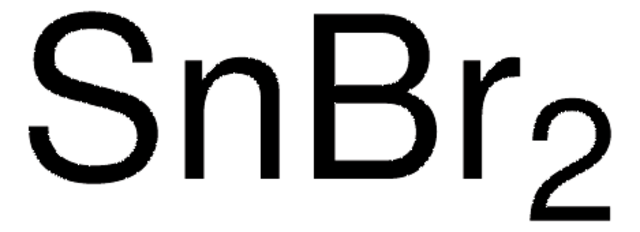추천 제품
일반 설명
Tin(II) chloride (Stannous chloride, SnCl2) is widely employed as reducing reagent. It plays significant role in diverse fields of science. Since it exhibits superior catalytic action in molten state, it is employed for the hydroliquefaction of coals. It is a promising raw material for the chemical vapour deposition (CVD) of semiconducting layers. It can be prepared by reacting its dihydrate form with acetic anhydride. It exhibits reducing properties in acidic media. It participates in the reduction of the following compounds:
- aromatic nitro compounds
- nitriles
- cyanosilyl ethers
- organic azides
애플리케이션
Tin(II) chloride has been used for the reduction of hydroperxoxides to the corresponding alcohols in a study.
Tin(II) chloride may be used:
- To catalyze the addition of diazo sulfones, diazo phosphine oxides and diazo phosphonates to aldehydes to form β-keto sulfones, β-keto phosphine oxides and β-keto phosphonates, respectively.
- Along with trityl chloride, to catalyze the aldol reaction of silyl enol ethers with acetals or aldehydes and the Michael reaction of silyl enol ethers with α,β-unsaturated ketones.
- As a promoter in the allylic amination of allylic alcohols with amines in the presence of palladium catalyst.
신호어
Danger
유해 및 위험 성명서
Hazard Classifications
Acute Tox. 4 Inhalation - Acute Tox. 4 Oral - Aquatic Chronic 3 - Eye Dam. 1 - Met. Corr. 1 - Skin Corr. 1B - Skin Sens. 1 - STOT RE 2 Oral - STOT SE 3
표적 기관
Cardio-vascular system, Respiratory system
Storage Class Code
8B - Non-combustible corrosive hazardous materials
WGK
WGK 3
Flash Point (°F)
Not applicable
Flash Point (°C)
Not applicable
개인 보호 장비
Eyeshields, Faceshields, Gloves, type P3 (EN 143) respirator cartridges
Choose from one of the most recent versions:
시험 성적서(COA)
Lot/Batch Number
Don't see the Right Version?
If you require a particular version, you can look up a specific certificate by the Lot or Batch number.
이미 열람한 고객
Quantitative assays for esterified oxylipins generated by immune cells.
Morgan AH, et al.
Nature Protocols, 5(12), 1919-1931 (2010)
Transformation of molten SnCl2 to SnO2 nano-single crystals.
Kamali AR, et al.
Ceramics International, 40(6), 8533-8538 (2014)
Tin (II) chloride catalyzed addition of diazo sulfones, diazo phosphine oxides, and diazo phosphonates to aldehydes.
Holmquist CR and Roskamp EJ.
Tetrahedron Letters, 33(9), 1131-1134 (1992)
Palladium-catalyzed allylic amination of allylic alcohols with tin (II) chloride and triethylamine.
Masuyama Y, et al.
Chemistry Letters (Jpn), 24(12), 1121-1122 (1995)
Tin (II) Chloride.
Faul MM and Thiel OR.
e-EROS Encyclopedia of Reagents for Organic Synthesis. (1995)
자사의 과학자팀은 생명 과학, 재료 과학, 화학 합성, 크로마토그래피, 분석 및 기타 많은 영역을 포함한 모든 과학 분야에 경험이 있습니다..
고객지원팀으로 연락바랍니다.







